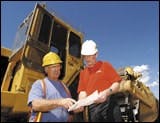Headquarters: Arvada, Colo.
Specialties: Earthmoving, underground utilities, concrete structures and bridges, commercial site prep
Equipment Value: $150 million
Fleet Makeup: 850 total units, 300 of which are major off-road pieces, 40 Class 8 trucks, 120 light trucks and cars
Support Staff: 52 total, including 21 shop and field mechanics
Facilities: One main shop, 9 mechanic's trucks, 7 fuel/lube trucks
Market Range: 700-mile radius
Q. How do you keep a fleet of 54 scrapers with an average age of 30,000 hours reliable and productive, and operating in a competitive cost range?
A. "Our average scraper is a little older than we'd like right now, but we do tend to keep them longer than the rest of our fleet because of their up-front cost," says Dave Torkelson, vice president of equipment at TARCO. "We roll in engine main bearings at 8,000 to 10,000 hours and rebearing and reseal turbochargers every 5,000 hours or so. At about 25,000 hours, we expect to do a frame-up rebuild on most scrapers."
Long life expectancies are common throughout TARCO's fleet, but they really stretch scrapers because of their durable frames and relatively stable technology. Torkelson upgrades excavators and wheel loaders more frequently, in large part because new models deliver greater production advantages. Average age of these lower-cost machines is about 12,000 hours.
The scraper fleet's average age drifted beyond Tarco's 11-year target during the busy 1990s. The firm bought some used machines based on conservative estimates of the boom's length.
"After living through the '80s," Torkelson says, "we were asking: 'how long will it last this time? Two years, maybe three?' It ended up lasting 10 years. In retrospect, we probably should have bought more equipment new, but we never could have anticipated that business would be so good for so long."
Older machines challenge the TARCO shop only in large quantity. The equipment division is staffed and equipped to handle all kinds of component repair and rebuild, but there was more service work during the peak of the economic cycle than they could handle. Their goal is to maintain support capacity to do 95 percent of their service and repair work.
"We're beyond that now," Torkelson says. Even with equipment hours down about 15 percent since the first of the year, he is sending more service work to local dealers than fits TARCO's do-it-yourself model.
"Maintenance operations have grown 20 to 25 percent in the past 10 years, but the equipment fleet has doubled," Torkelson explains. "Production has been growing 10 percent each year since about the time I came to work here in 1989."
As fleet growth outstripped the equipment division's support capacity, Torkelson has learned to make judicious use of dealer support. For example, when there's need for electronic diagnostic work in the field, he'll often call the dealer in to troubleshoot.
"They usually send out the tech van on newer electronic stuff to hook up a laptop in the field, anyway. Then they'll send out a mechanic's truck to fix the problem," he says. "Rather than pay them double for travel time, we'll handle the repair ourselves. If I don't have a guy available, we can always leave the repair to them, too."
The hardest pill to swallow is paying a service labor rate that is nearly double their own. Torkelson has cultivated his own mechanics' specialized expertise to keep his fully burdened rate well below retail. Relying too heavily on outside service labor unsettles the firm's cost structure, but it has become necessary.
"Because we own so much iron, I don't have enough people on staff to do 2,000-hour inspections and service on all of our scrapers," he says. "So I keep one scraper on 2,000-hour service going in our shop at all times, and we usually have one in the Cat dealer's shop. It has taken me almost two years to get through the entire scraper fleet, and it's time to start over again. There's always at least one scraper in the shop getting a frame-up rebuild, too."
Torkelson says his technicians are among the best scraper mechanics in the business, thanks to rebuilding so many different models. Few dealers can match their expertise with older machines.
"We send our newest machines to the dealer for 2,000-hour inspections and, when our spec shop is full, we send the newest components that need to be rebuilt," Torkelson says. "We're willing to take a chance and fix some things, whereas the dealer is primarily changing parts. Inevitably, parts costs on a given job will be 20 to 40 percent higher when the dealer does it.
"His people are working on the machine to make money. My people are just fixing the iron so we can get it back out on the job and be productive."
TARCO spends an average of $320,000 repairing and rebuilding a scraper over its 50,000-hour life span. Torkelson considers it a reasonable investment, compared to replacing units at more than $900,000 each. Yet maintaining the economic advantage of older scrapers requires careful balancing. He watches costs and utilization, using the equipment-management module of the firm's software package from Computer Guidance Corp. to be sure machines don't stray too far above the average repair cost, and that they remain reliable.
TARCO scrapers averaged 2,000 hours per year over the past 10 years, so there's little room for downtime. The oldest scraper in the fleet, a 1976 model Cat 633C, is an example of the firm's ability to keep older machines productive.
"It's the first machine the company ever bought brand new, and it has only had one operator since 1976," Torkelson says. "He's getting close to retiring, and he came into my office the other day and said, 'I want to see the operating costs and production numbers on that machine.' That unit has 59,900 hours on it, and it's one of our lowest costs per hour."




